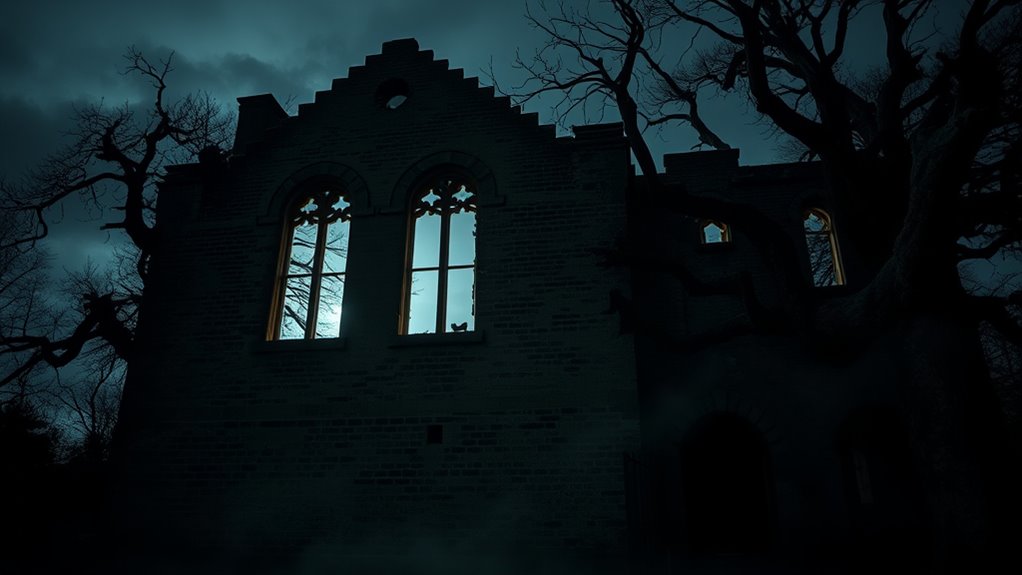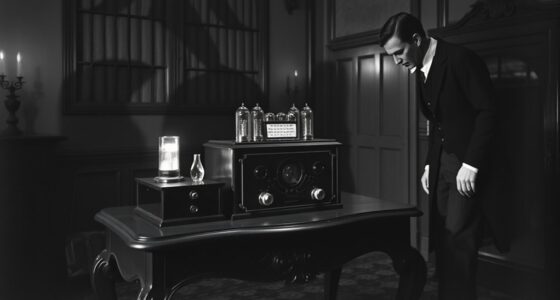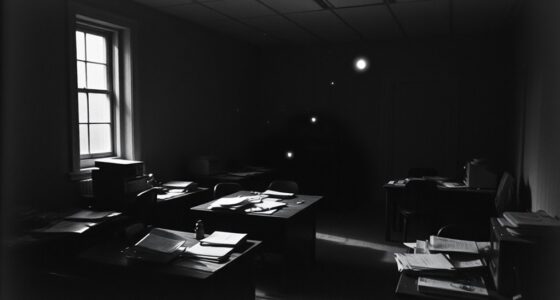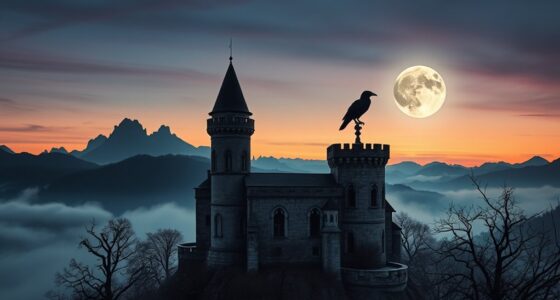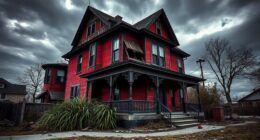Borley Rectory’s haunted history begins in the late 19th century with local reports of ghostly sightings and strange noises. In 1929, Reverend Lionel Foyster and his family experienced unsettling encounters, drawing widespread attention. Paranormal investigators in the 1930s captured photographs and recorded unexplained phenomena, though skeptics debated their claims. After the house burned down in 1939, stories persisted, shaping its legendary reputation. Exploring this timeline reveals how legends grow—if you keep exploring, you’ll uncover even more intriguing details.
Key Takeaways
- Early reports of ghost sightings and strange noises date back to the late 19th and early 20th centuries.
- Reverend Lionel Foyster and his family experienced notable paranormal encounters in 1929.
- Paranormal investigations in the 1930s documented photographs and electromagnetic anomalies.
- The rectory was destroyed by fire in 1939, yet hauntings and legends persisted.
- Borley Rectory’s haunted reputation has significantly influenced British paranormal folklore and media.
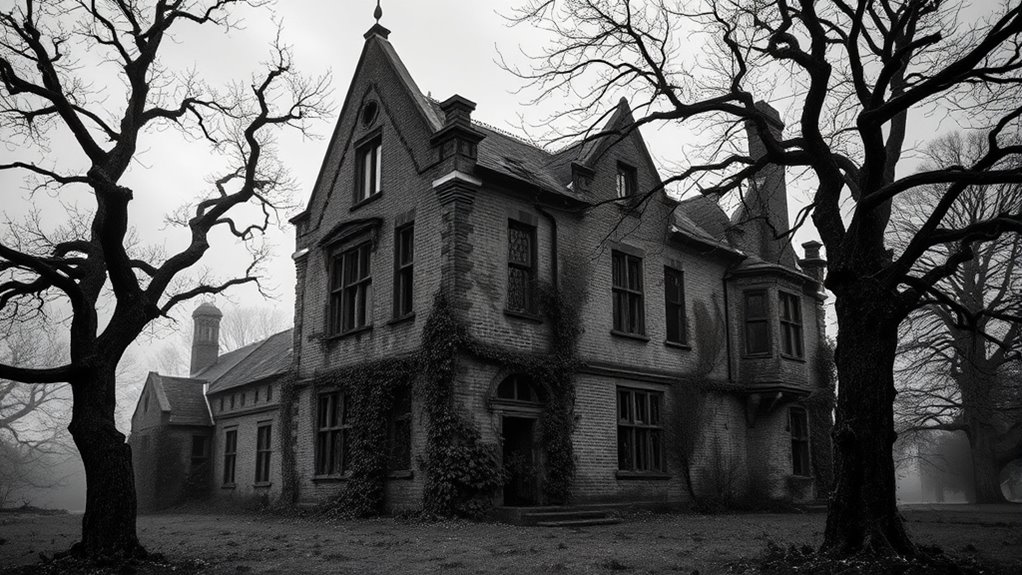
Borley Rectory, often called the most haunted house in England, has a tumultuous history filled with mysterious events and ghostly sightings. Over the years, its reputation has been shaped by countless haunted legends that continue to fascinate and terrify those interested in the paranormal. As you explore its history, you’ll find that many of these stories have been documented through various paranormal investigations, which sought to uncover the truth behind the eerie phenomena reported by residents and visitors alike.
Borley Rectory: England’s most haunted house with ghost stories documented through paranormal investigations.
The earliest reports of supernatural activity date back to the late 19th and early 20th centuries, when locals claimed to see ghostly apparitions and hear strange noises coming from the rectory. These accounts fueled rumors and added to the house’s reputation as a haunted location. In 1929, the story gained widespread attention when the Reverend Lionel Foyster and his family moved into the rectory. They experienced a series of unsettling encounters, including mysterious footsteps, unexplained voices, and sightings of a ghostly nun and a phantom coach. These chilling events sparked a flurry of paranormal investigations, with investigators keen to document the supernatural activity.
Throughout the 1930s, numerous teams visited Borley Rectory, aiming to gather evidence of its haunted legends. Some claimed to capture photographs of apparitions, while others reported strange electromagnetic readings and unexplained noises. Despite these efforts, skeptics argued that many of the phenomena could be attributed to hallucinations, pranks, or natural causes. Nevertheless, the stories persisted, and the house’s reputation as a haunted site grew stronger. The rectory’s haunted legends have since become a staple of British paranormal folklore, inspiring books, documentaries, and ghost-hunting expeditions.
In 1939, the rectory was destroyed by fire, but the stories of its hauntings continued. Today, researchers and ghost enthusiasts revisit the site, analyzing the historical records and testimonies that make up its timeline. Many believe that understanding the house’s haunted legends requires examining both the firsthand accounts and the investigations that attempted to authenticate them. Whether you’re skeptical or a believer, Borley Rectory remains a fascinating chapter in the history of paranormal investigations, illustrating how haunted legends can endure and evolve over time. As you explore into its history, you’ll see how each investigation and story adds layers to its mysterious reputation, making it a compelling case study in the enduring power of ghost stories.
Frequently Asked Questions
Who Was the Most Prominent Ghostly Resident at Borley Rectory?
The most prominent ghostly resident at Borley Rectory is the White Lady. You’ve likely heard about her haunting legends and numerous ghostly sightings over the years. She’s famously associated with the rectory’s eerie atmosphere, often seen wandering the grounds or appearing in windows. Her presence has become a symbol of Borley’s haunted reputation, mesmerizing those interested in paranormal stories and mysterious ghostly encounters.
Are There Any Recent Paranormal Investigations of Borley Rectory?
Yes, there have been recent paranormal investigations of Borley Rectory. Modern ghost hunting teams use advanced paranormal equipment like EMF meters, infrared cameras, and audio recorders to capture evidence. You might find that enthusiasts and researchers continue to explore its haunted reputation, hoping to uncover new phenomena. These investigations often aim to verify past reports and deepen understanding of the ghostly activity associated with Borley Rectory.
What Were the Legal Disputes Surrounding Borley Rectory?
You might find it surprising, but Borley Rectory faced intense property disputes and legal proceedings. Landowners and inheritors argued over its ownership, fueled by rumors of haunting claims. These disputes often delayed renovations and kept the site embroiled in legal battles. The tension between superstition and law created a complex backdrop, making Borley Rectory not just a haunted house but also a symbol of ongoing legal contention.
How Did Local Residents Perceive Borley Rectory Over the Years?
You see, local residents have long viewed Borley Rectory with a mix of fear and curiosity. They believed local legends about ghostly apparitions and strange noises, which fueled community reactions ranging from skepticism to genuine terror. Over the years, many locals considered it haunted, sharing stories that kept the legend alive. Their perceptions turned Borley into a symbol of ghostly mysteries, shaping how the community interacted with and interpreted the site.
What Is the Current Status or Use of the Borley Rectory Site?
You might be surprised to learn that the Borley Rectory site is now a peaceful field, with preservation efforts protecting its history. Once known as England’s most haunted house, it’s undergone site redevelopment to prevent further decay. Today, the land stands as a reminder of ghost stories and local legends, with historians and enthusiasts working to preserve its legacy. It’s a quiet tribute to a storied past.
Conclusion
As you reflect on Borley Rectory’s story, remember it’s more than just bricks and mortar—it’s a mirror to our fears and mysteries. The rectory stands as a silent sentinel, guarding secrets from the past that continue to echo through time. Its ghostly presence symbolizes the enduring human urge to seek answers beyond the visible, reminding us that some mysteries, like shadows, persist long after the lights fade.
